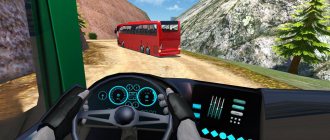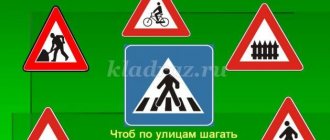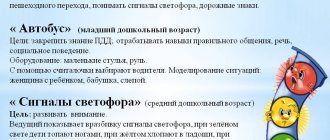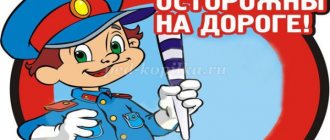Traffic rules quiz
- On the back of the bus/trolleybus there is an inscription: “Skid - 1 m” or “Danger when turning.” What is its significance?
(The above vehicles may lose control while turning, putting the lives of nearby passersby at risk.)
- What is the threat from bushes and trees planted along the edges of streets?
(They limit the view of the street and the movement of vehicles; a pedestrian may not notice a car that suddenly leaves from behind the plantings).
- How to move near the road if there is no sidewalk?
(If there is no sidewalk (for example, in the suburbs), you should move along the side of the road, on the left side, so that traffic moving in the oncoming lane is clearly visible).
- Why should you be wary of vehicles with trailers?
(Because when a car turns, the trailer can skid, hitting one of the pedestrians; an absent-minded passerby, deciding that the car has already passed, will begin to cross the highway and fall under the trailer).
- What is the braking distance of a car if the driver reacts instantly?
(Depends on the current speed, on average - 10-20 m).
- Why does a pedestrian need to be vigilant when cars moving towards each other are nearby?
(A car moving on one side passes another car, and at this moment the driver and the passer-by do not notice each other).
Rules
- Where is it unsafe to cross the road - at a street intersection or near a bus stop?
(Both of these areas are potentially risky to cross. However, stopping is considered more unpredictable, especially for children.
- After getting off the bus, the child hurries to cross the road as quickly as possible, going around it in front or behind. At the same time, it does not focus on a car driving around a bus or moving in the oncoming lane.
- Trying not to be late for a bus that has arrived at a stop on the opposite side, the child will not notice the car on the road, which can lead to an accident.
- In unfavorable weather conditions, a braking bus may lose control and hit passers-by at the stop.
- When passengers enter and exit the bus, there is a chance that the one who hesitates will be crushed by the closing door).
- Can a car driver see a pedestrian every time he approaches him?
( No. The driver must not lose sight of both passers-by on the sidewalks and at pedestrian crossings, as well as other drivers. It is extremely unsafe for a pedestrian to cross the road at dusk - if caught in the headlights of 2 cars moving towards him, it is almost impossible to see him.
- What factors cause the greatest difficulties for driving and crossing roads in the city?
(There are several such factors:
- It is quite difficult to see a small passenger car or moped in advance, since the roadway is “full” of trucks, buses, etc. When stopping or moving, they hide small transport objects.
- The roadway of the street is sometimes planted on the sides with trees and shrubs; nearby there are fences, billboards, buildings built close to the road - all this reduces the view of the street).
- The greatest dangers lie near the roadway.
(A car moving at high speed is unsafe, but passenger cars or larger transport objects that are not moving pose no less of a threat: a stationary car can obscure another car that is in motion and inaccessible to the pedestrian’s view; without paying attention to it , the passer-by believes that there is no threat and crosses the road, falling under the wheels of a car).
For children
- a Zebra sign give any privileges to a passer-by to cross the roadway?
(No, this sign only indicates to the passer-by a place where it is not prohibited to cross the roadway. On a zebra crossing, where there is no traffic control, passers-by are allowed to enter the roadway only after first assessing how far it is to the approaching vehicle , how fast it is going and making sure that it is safe to cross the street).
Test for parents traffic rules
Test for parents
Dear parents, spend a few minutes with your children discussing the important topic of road safety. To begin, invite your child to truthfully answer questions about how he would or could act in similar situations.
The child has approached the road and is located at a distance from a safe place to cross the roadway. What will he do in this situation?
A
- will go to the nearest pedestrian crossing or intersection, even if he has to deviate from the path of his direction, where he will cross the road;
B
- will allow the main flow of cars moving along the roadway to pass and quickly cross the road. A child in front of a pedestrian crossing?
A
- before entering the roadway, make sure that cars give way to him or are at a safe distance from the pedestrian crossing;
B
- confidently enters the roadway, rightly considering this area safe and specially designed for pedestrians. A child at an intersection controlled by a traffic light?
A
- will cross the road when the traffic light is green, allowing the crossing of the roadway, only after making sure that vehicles are giving way to pedestrians;
B
- will cross the roadway at any traffic light if there are no moving cars. What does road behavior mean to your child?
A
— a person must be cultured always, everywhere and in everything, including on the road with other road users;
B
- in some cases, for example on the road, the culture of behavior is completely inappropriate.
Summarize:
The majority of answers are
“A” :
Your child is attentive, prudent, punctual and well-mannered.
You don’t have to worry about his independent walks along the city streets; for him, the shortest path is safe. Equal number of answers “A” and “B” :
Your child knows well how to behave on the roads, but lack of self-discipline can lead to rash actions.
You should draw the child’s attention to the seriousness of the consequences of such actions, teach them to save distance and time without endangering their own lives. The majority of answers are “B” :
Your child is not familiar with the rules of safe behavior on the roads or is overly self-confident. Take this problem seriously and do not give your child the opportunity to make irreparable mistakes.
Traffic Laws _
Dear parents!
According to official statistics, every year preschoolers are run over by cars on the roads of our city. Children, due to their age, are not always able to correctly assess the road situation and recognize danger. Do everything necessary to prevent trouble from coming to your family. Timely teach children the ability to navigate traffic situations, cultivate the need to be disciplined on the street, careful and prudent!
Blitz questionnaire on traffic rules
- A vehicle on four wheels that can move independently. (Car).
- The name of horse-drawn transport used in ancient times. (Coach).
- How can you transport more passengers than a car? (By bus).
- A favorite vehicle for active boys, they ride it by pushing off with their feet. (Scooter).
- A car that can move even on the worst roads. (SUV).
- "House" for the car. (Garage).
- A place where planes stay between flights. (Hangar).
- Passerby walking along the sidewalk. (A pedestrian).
- The name of the alley in the middle of the street. (Boulevard).
- Where do the trams go? (On the rails).
For children - A road section intended for pedestrian movement. (Sidewalk).
- Who is driving the car? (Driver).
- Who flies the plane? (Pilot, pilot).
- What can you use to stop a car? (Brakes).
- The name of the striped markings for pedestrians. (Zebra).
- Where do the streets intersect? (At the crossroads).
- What do special vehicles use to honk loudly: ambulance, fire, police? (With the help of a siren).
- A place where pedestrians become passengers on public transport or disembark from it. (Stop).
- Reliable wide fabric stripes that can reduce the danger for the driver and passengers in a passenger car. (Seat belts) .
- What does a motorcyclist wear on his head to protect it from injury? (Helmet) .
- What do you call a passenger who likes to travel without a ticket? (Hare).
- A single name for large vehicles of various types that transport a large number of citizens. (Public transport).
- What do you call someone who rides in a vehicle but is not behind the wheel? (Passenger).
- Ticket seller in public transport. (Conductor).
- Public transport running underground. (Metropolitan).
- Mobile staircase in the underground. (Escalator).
- Where is the driver of a car, bus, trolleybus, tram. (In the cockpit).
- A sports facility where circuit cycling races are held. (Cycle track).
- What is the name of the area where the railway tracks intersect with the highway? (Moving).
- The name of the crossbar that opens and closes the railway crossing. (Barrier).
- What do the rails rest on? (On the sleepers).
- A road outside the city, covered with asphalt, along which vehicles move. (Highway).
- A ditch for drainage of water located along the road. (Ditch).
- What does a car use to move? (Using wheels).
- How does a driver see the road in the dark? (Turns on headlights).
- The name of the part of the truck in which goods are transported. (Body).
- A truck whose body can dump its own cargo. (Dump truck).
- The motor is hidden under this cover. (Hood).
For children - How can you tow a car? (Using a cable).
- The name of the underground structure through which vehicles move. (Tunnel).
- The name of the car coincides with the name of a large river in Russia. (Volga).
- What do you call a pedestrian or driver who does not follow traffic rules? (Violators).
- How are traffic violators punished? (They charge a fine).
Quiz on traffic rules for preschoolers 5 - 6 years old
Quiz on traffic rules for older preschool children
"What? Where? When?" according to traffic rules in kindergarten. Senior group
Author: Elena Andreevna Permyakova, teacher of the Municipal Educational Institution No. 21 “Iskorka”, Berdsk Description: This development is designed for children of senior preschool age, and is intended for teachers of preschool educational institutions, promotion inspectors of the State Traffic Safety Inspectorate of the Department of Internal Affairs. Goal: To develop children’s skills of correct behavior on the road and in transport. Objectives: 1. To consolidate children’s knowledge about the elements of the road (roadway, pedestrian crossing, sidewalk). 2. Reinforce basic traffic rules, rules for the movement of pedestrians and cars. 3. Consolidate knowledge about road signs (ground, overground, underground passage). 4. Strengthen children’s knowledge about special transport and related professions. 5. Foster a culture of behavior on the road and in transport. Preliminary work: 1. Thematic conversations 2. Learning poems on this topic 3. Watching cartoons on this topic.
4. Design of an exhibition of crafts and drawings on the topic of traffic rules. 5. Invitation from the traffic police department propaganda inspector. Progress of the quiz
Educator: Hello, dear children and distinguished guests! Today we are playing the game “What? Where? When?" according to traffic rules. As you remember, two teams participate in this game: experts and television viewers. We also have two teams: experts and spectators in the hall. For the game, we selected the most interesting, in our opinion, questions and placed them on this playing field. Now I ask a team of experts to take a seat at the gaming table. Each game has its own rules.
Here are the rules of our game: 1. We play up to 6 points.
The first team to score the required number of points wins. 2. The judge monitors compliance with the rules and puts the score on the scoreboard (shows): blue for the team of spectators, red for the team of experts. So, pay attention! The game begins! The score is 0:0. First round The top spins, stops, the arrow points to the sector (black or white). Question No. 1: The propaganda inspector of the State Traffic Safety Inspectorate of the Department of Internal Affairs is playing against the experts....... Dear experts, guess these riddles: 1. My three magic eyes Control everyone at once. I blink - cars will start walking, women and men will stand up. Answer together in unison: What is my name? ... (traffic light) 2. The houses stand in two rows: 20,30, 100 in a row And with square eyes, everyone looks at each other. (Street)
3. A house walks down the street, calls everyone to work, wears rubber shoes and eats gasoline. (bus)
4. Strange zebra: Doesn't eat or drink, But without food and drink it won't die. (pedestrian crossing) 5. Without accelerating, it takes off skyward, reminding one of a Dragonfly. (helicopter) is taking flight 6. You must always know for sure: For cars there is a pavement, For passers-by... (sidewalk) 7. It has two wheels And a saddle on the frame, There are two pedals at the bottom, They turn them with their feet. (bicycle) 8. A miracle - a bird, a scarlet tail, Flew into a flock of stars. (rocket) 9. If you are in a hurry on your way to pass through the street, go there, where all the people are, where the sign is... (transition)
Second round Educator: Dear experts! In this task you need to complete the phrase with the word “prohibited” or “allowed”. So, I'm reading a poem, listen carefully. And the avenues and boulevards - The streets are noisy everywhere. Everyone walks on the sidewalk only on the right side! Here to be naughty, to disturb the people... (prohibited)
If you are riding on a tram, and there are people around you, do not push, do not yawn, always walk forward.
Riding as a “hare,” as you know, ... (prohibited)
Giving way to old ladies ...
(allowed)
.
If you are just walking, Still look ahead, Walk through a noisy intersection with caution. Crossing when the light is red... (prohibited).
When it’s green, even children...
(allowed)
To be an exemplary pedestrian
(allowed)
(V. Semernin)
Third round Educator: Attention! Black box! Dear experts! The box contains toy cars. Please arrange them by type of transport. Fourth round Outdoor game “Driver and Passengers”. Two teams of children (experts and spectators) participate. In each team, the “driver” is the first participant and the “passengers” are the other participants. On the command “March!” The first players quickly walk (it is forbidden to run)
to their flags, go around them and return to the columns, where they are joined by the second players, and together they make the same path, then the third ones join them, etc.
The players hold each other's elbows. When the team returns to the place with a full complement of passengers, the “driver” must sound the whistle. The team that arrives at the final stop first wins. Fifth round Teacher: Attention! Black box! Dear experts, guess what kind of item is in the “black box” and who needs it. This object is held in the hands of a person who stands at an intersection and controls the movement of cars. (traffic police inspector's baton)
Sixth round Teacher: Attention! Black box! The traffic police inspector is playing against the experts... Dear experts, please explain what these road signs mean.
Seventh round Educator: Dear experts. Now you must go through the three types of pedestrian crossings you mentioned earlier: ground, overground, underground. Relay game “Pedestrian crossing” A team of experts and a team of spectators are invited for the relay race. You need to, at the signal, walk along the pedestrian path (overground passage)
, then along the gymnastic bench
(overground passage)
, then crawl under the arc
(underground passage)
and return to the end of the team.
Eighth round Educator: Dear experts, answer the question: what is the correct way to cross the road at a public transport stop? (Wait until the vehicle leaves and cross the road at the crossing). Ninth round Cards with images of the following vehicles are brought out on a tray: fire, ambulance, police, Ministry of Emergency Situations.
Educator: Dear experts, name and explain what each of these machines is needed for. Tenth round Teacher: Attention! Black box! Dear experts, tell me on the card who is driving the vehicle.
(With a tractor - a tractor driver, an airplane - a pilot, a taxi - a taxi driver, etc.) Eleventh round Educator: Dear experts, tell me how to behave correctly in public transport?
Twelfth round Educator: Dear experts, tell me, is it possible to play on or near the roadway? Summing up Educator. So our game has come to an end. To sum up the results of the game, I invite the propaganda inspector of the State Traffic Safety Inspectorate of the Department of Internal Affairs...
We recommend watching:
Leisure time in the senior group on traffic rules Scenario of a speech by a propaganda team on traffic rules for children in the senior group Conversation in the senior group on the topic: Traffic rules Musical entertainment in the senior group of a kindergarten on traffic rules. Scenario
Similar articles:
Summary of a lesson on traffic rules in the senior group in kindergarten. Rules for pedestrians and passengers
Summary of a lesson on traffic rules in the senior group in kindergarten. Types of traffic signs. Warning road signs
Summary of a lesson on traffic rules in the senior group of kindergarten. Rules for cyclists
Tasks on traffic rules for preschoolers in pictures
Parent meeting on traffic rules in kindergarten





